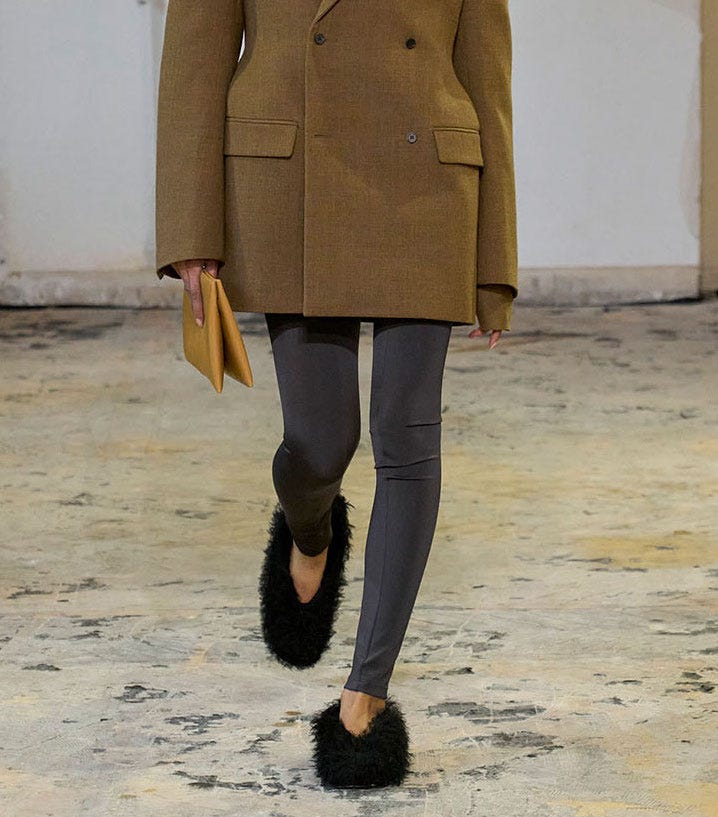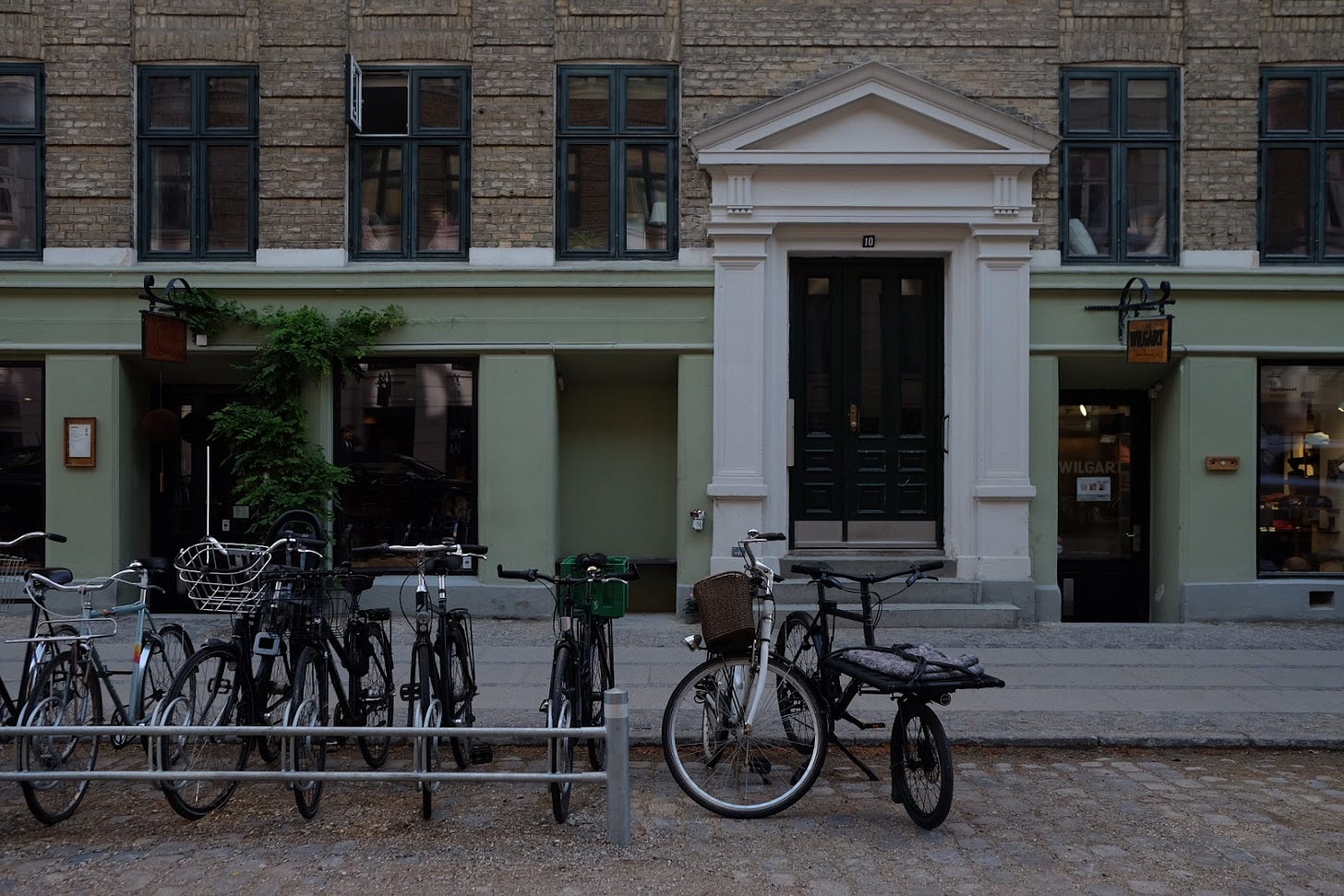You hear it in the “wrong shoe” theory (credit to Allison Bornstein) that rattles frequently around the halls of style Substack; you see it in the contrast-forward styling choices heading down the runways and cobblestones of the ongoing fashion weeks this season, you hear it in Amy Smilovic’s voice advising you to reach for antonyms if what you’ve put on feels a bit one-note: Friction is a good thing.
Obviously, there’s nuance here: friction takes many forms, and some can grate or overwhelm. But the general idea is that by bringing together items that seem to belong in different worlds, we can create interest, dimensionality, and maybe even some drama. A spark, if you will. Rather than mimicking an aesthetic, we can use friction to convey a more complex and human version of ourselves. If one is equally at home in sweats and delicate slingbacks, why not wear them together? Why insist on hermetically sealed categories, when smashing down the walls in our closets can yield so many more interesting results?


Personally, I am all about this. It requires continually engaging with the past choices you made around what to add to your closet, and how to bring them into conversation with one another. It requires thinking not only about the aesthetics of what you wear, but about how those choices make you feel. It’s about getting interested in getting dressed as an (albeit low-stakes) way of deciding and constructing part of our daily experience.
I can’t help but wonder if the reason this concept of creating “good friction” in the way we dress resonates with so many of us is because it’s inaccessible—or wholly absent—in so many other areas of our lives. I am thinking particularly about our neighborhoods, and the way the vast majority of them are designed in the North American context. It is literally illegal to build anything other than a single-family home on most available land in America. Which leads to a lot of variations on this fundamental theme, illustrated helpfully here by some stock imagery:
This is essentially the head-to-toe athleisure of neighborhood design. Sure, it’s comfortable and it’s safe, but there is nothing here to create interest, nothing to hold onto. Nothing memorable or exciting. In short: it is frictionless. The houses are painted in inoffensive yet soul-diminishing hues; they’re all roughly the same size. But the most crucial thing about these neighborhoods is that they are only made up of houses. You will find no coffee shops, no restaurants, no groceries stores, no art galleries, no shops. There may be a manicured park in the mix, or some walking trails, but functionally, these are single-purpose neighborhoods, and that is by design.
All right, stay with me for this—we’re going to talk about zoning.
The sheer dominance of this form of neighborhood in North America traces back to industrial times, where factors like pollution and noise raised the necessity of separating industry from where people lived. The general idea was to eliminate conflicts that could result from the juxtaposition of incompatible uses, like factories and homes. But it did not take long for this original justification to bleed into racism. Mortifyingly, Berkeley, California—not far from where I grew up—enacted the country’s first single-family neighborhood zoning ordinance in 1916 to prevent a Black-owned dance hall from opening in the area. Exclusionary zoning’s long shadow has perpetuated segregation and racism and contributed to the housing crisis evident in many of our cities today. There is a long, winding, and important rabbit hole I could lead you down around zoning (if you’re interested in joining me there, this book is a good place to start), but for the purposes of right now, I want to talk about how it makes so many of our lived experiences much more boring than we deserve.
Let’s go back to stock-image neighborhood. Legally and logistically, this is the easiest type of housing to build in America, and consequently you see developments like this springing out of the ground like daisies. Especially as a Californian, it’s hard to knock this—as a state, due to the reasons above, we are in desperate need of housing, and anything helps. But as I see these developments take root, what runs through my head sounds something like: We should be doing better than this.
And by better, I mean adding some friction. Some opportunities for creativity, spontaneity, different experiences. Some ways to bring different parts of our lives and our interests into conversation with one another, through place.
One of my favorite things that I’ve looked at recently, courtesy of my friend Gyasi, is this competition out of Vancouver that asked people to imagine ways to spice up single-use residential neighborhoods (here’s a fun video to watch for a general overview of some of the concepts). It is striking to me how simple and achievable and lovely these ideas are—like converting garages into small businesses—and yet how illegal they remain in so many of our cities. When I lived in Seattle during COVID, some people opened an incredible cider bar in their garage in a residential neighborhood. It was an instant success—people flocked to the tiny business, drawn by the novelty and what it brought to the community. Keeping it open, though, was another matter—through the lens of local zoning, small businesses and homes shouldn’t mix. The response from the people, though, said otherwise. Where the city frowned on this introduction of friction into the neighborhood, the people embraced it.
There is a simplicity inherent in separating out the functions—in our wardrobes, and in our lives. But ease without that good friction is just boring. My dream, and the reason I work in the field of urbanism, is for people to feel like they can bring more of themselves into their environments; for cities to become places that reflect our needs and desires and creativity. If we’re becoming more ok—as, delightfully, it seems that we are—with throwing out long-standing fashion “rules,” let’s do cities next.
“Cities have the capability of providing something for everybody, only because, and only when, they are created by everybody.” — Jane Jacobs, the realest






I didn't understand what single-home zoning meant until I moved to Melbourne, because I've always lived in incredibly dense (some say too dense) urban environments. And you are right: single-purpose environments feel incredibly lifeless! I don't particularly want to live over a bar (the noise, the vomit splatters, the cigarette smoke, been there done that) but thoughtfully-planned mixed-use environments are what communities are made of, and it's so interesting to think about fashion in those terms. We can't grow as a community (and as people) without a bit of friction.
When I moved to America, I landed into my uncles SFH in Cupertino. I was baffled by the boring neighborhood and the ugliness of it all. Is this the developed nation of America, I wondered. Why did I move here from the vibrant city I used to live in, I wondered. I kept going for walks and was stunned by how uninspired it all looked on the surface. He then drove me to Stanford to show me around. The university town was anything but boring. I have since lived in university towns and downtowns, for the most part. The suburbs continue to be soul sucking with the lawns with SUVs parked upfront. I am currently in such boring place plotting my escape.
Thank you for bring urbanism into the conversation. It has been quite difficult for me to convince folks that we need more of it to address housing, biodiversity and climate crisis. With the election year, my climate org has decided to be silent on its YIMBY goals to not push people away. Climate people eat their own, is our general consensus. Dont go after their cottages with the talk of townhomes and apartments, is the vibe. Fingers crossed on future wins.